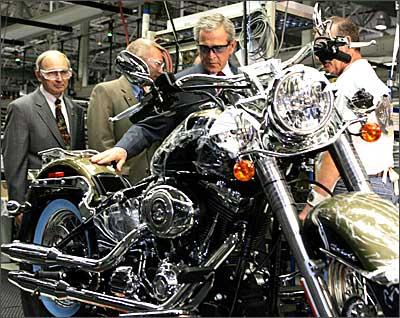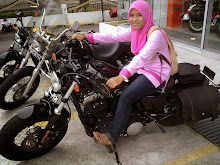The history of the Harley-Davidson motorcycle began in Milwaukee in 1903. In Milwaukee, Bill Harley and Arthur Walter Davidson developed a one-cylinder motorcycle. Around the turn of the century the gasoline engine was developed and the one-cylinder motor was introduced. In 1901 the Indians were the first motorcycles and in 1903 Mitschell, Merkel and Yale.
This motorcycle was initially built for racing and was powered by a one-cylinder gasoline combustion engine.

Picture from 1916
In 1903 in Milwaukee, Bill Harley and Arthur Walter Davidson developed a one-cylinder motorcycle. It was a reliable and even a beautiful cycle. And ... someone bought it !! In 1905 they had made 11 motorcycles, in 1908 it were 154 and ... they had a company, in a little wooden barn, that was build by Davidson's father.
The small company extended quickly and another member of the Davidson family, William, joined them. In no time they hired about 20 employees in an especcially build stone-factory.
In 1909 Bill Harley made a project of the first 1000 CC V-Twin. It produced a modest seven horsepower. The 45-degree V-twin would become one of the more recognizable images of the Harley-Davidson motorcycle. This V-Twin stayed with HD for a long, long time. Maybe it's hard to believe, but Harley-Davidson didn't invent the V-twin !! When Bill Harley developed one, he just followed the tendency of the time.
1910 brought the legendary "Bar and Shield" logo that was placed on their motorcycle. This would become the defining symbol of Harley-Davidson to this day. Numerous first place winnings in races, endurance contests and hill climbs give Harley-Davidson more recognition.
The "F-head" engine is introduced in 1911. It will be the power workhorse until 1929, when the "Flathead" engine is introduced.
Arthur & Walter Davidson, William S.
Harley and William A Davidson (1915)
The year 1912 saw further growth of the Harley-Davidson Company. Construction began on a new 6-story factory. Harley-Davidson also became an exporter this year and their first overseas sale was made in Japan. In the states there were now over 200 dealerships.
1914 saw the addition on the sidecar to the Harley-Davidson. The Company also formally put their hand in the ring of motorcycle racing this year and would soon dominate the sport and become known as the "Wrecking Crew".
1915 saw the emergence of the three-speed sliding-gear transmission. In 1917, one-third of all Harley-Davidsons were sent overseas to the U.S. Military to fulfill their patriotic call and to aid in the war effort. The following year, roughly half of the motorcycles produced were sold to the U.S. military. In the end, about 20,000 motorcycles were used in the war, most of them Harley-Davidsons. By this time Harley-Davidson was the biggest motorcycle factory in the world with nearly 2,000 dealerships worldwide. In 1918 Harley-Davidson was the biggest motorcycle factory in the world. They even survived the depression. The V-twin was Harley's specialty, so the company tried to defeat its only remaining rival ... Indian.
But these days were the thoughest, because the motorcycles got out of date and the prices of automobiles decreased (the T-Ford was born).
Therefore, Harley Davidson tried other technical enterprises, like manufacturing parts, side cars and even airplane motor-engines, but they also improved their own products.
The 1920's saw some changes to the appearance of the motorcycle, which are more recognizable today. One such change was the identifiable teardrop shape gas tank. In 1926, single-cylinder engines were once again available, having been discontinued in 1918. In 1928, the first twin-cam engine and front wheel brakes were available on the Harley-Davidson. With this modification, the motorcycle could reach speeds in excess of 85 mph.
The 1930's and subsequent years saw more record breaking and award winning Harley-Davidson's. In 1932, the three-wheel Servi-Car was introduced and would become a familiar commercial and police vehicle. Along with appearance changes such as the "eagle" design, which was painted on all Harley-Davidson gas tanks, changes were also made to the engine.
These days the biggest Harley ever appeared , the 1340 CC. This motorcycle became Harley Davidson's trademark. 1936 also became a milestone. That year the Knucklehead was launched and this motorcycle also became the victory over the Indian. And when in 1947 the Panhead was driven out of the factory, Harley Davidson was THE American Motorcycle.
In the 1940's, the Harley-Davidson once again answered the patriotic call and sent its motorcycles overseas to aid in the war effort. In 1941, civilian production on the motorcycle was mostly suspended as the company turned out motorcycles for the war. Because of their commitment and excellence, Harley-Davidson received the Army-Navy "E" award; this wouldn't be the last time. In November of 1945, civilian production once again started. In 1947, Harley-Davidson purchased the old A.O. Smith Propeller Plant and used it as a machine shop. The parts made here were shipped back to the old factory on Juneau Avenue for final assembly. In 1949, hydraulic front brakes were introduced on the Hydra-Glide models.
In the fifty's Harley survived another bad period. The Brittish owned 40 % of the motorcycle market with their Triumph ! In 1957 fortunately the Sportster was born, the fastest Harley ever. A great success !! Just like the English motorcycle industry, Harley stuck to its technic, style and caracter. That's why this motorcycle was so populair for many, many years.
In opposite to the English manufacturors, Harley Davidson survived this decision. Due to the enormous attack from the Japanees from the Far East, the English dissapeared without a trace and the American were almost dead. Even the Shovelhead couldn't save its ass.
1969, Time for a merger with the American Machine and Foudry Company (AMF).
However, the quality decreased ernormously and the Super Glide and the SLCR Caféracer of 1970 got a bad name. But Harley Davidson bought itself out and survived and with launching the new Evolution-motor in 1984, the company managed to create a modern motorcycle, which was still a Harley Davidson.
Historic Factory
The beginning of the 1970's saw a revolution of the Harley-Davidson. In 1971, the cruiser was born. This machine united a sporty front end with the frame and power train of the FL series. 1973 saw the move of assembly operations to a new 400,000 square foot plant in York, Pennsylvania. The year 1975 was the first of four consecutive years that the Harley-Davidson won the AMA Grand National Championships in dirt track racing. In 1977, the FXS Low Rider and the FLHS Electra Glide Sport were introduced to the public. The FXS featured a special lower seat position (hence the distinguishing term Low Rider...). The FLHS was a low cost base line FLH Electra Glide with modifications intended to make the model sportier.
The beginning of the 1980's saw another change in the partnership of the engine and transmission. In 1980, the FLT model was born with a 5-speed transmission hard bolted to the engine. Also this year, the drive train was replaced with a Kevlar belt. In 1981 senior members of Harley-Davidson bought back Harley-Davidson Motor Company from AMF.
In 1982 Harley-Davidson enacted the Materials as Needed (MAN) application in their production. This would cut production costs and improve the quality of the parts. In 1983 the group H.O.G was founded and became the largest factory-sponsored motorcycle club in the world. By the year 2000, the club had over 500,000 members. In 1984 the 1340 cc V-twin engine was introduced, seven years in the making. Also this year, the Softail model became available. The Softail was most primarily distinguishable by hidden rear shock absorbers.
In 1987 Harley-Davidson began its "Buy Back Program" which offered full trade in value within two years on certain models. Also at this time, the Harley-Davidson Company obtained a place on the New York Stock Exchange for those interested in taking a financial stake in the company. In 1988 Harley-Davidson celebrated their 85th Anniversary in Milwaukee, an event that brought forth 60,000 aficionados of the Harley-Davidson. At the end of this revolutionary decade for Harley-Davidson, the FXSTS Springer Softail model was introduced into the lineup. The FXSTS Springer Softail was a modern day recreation of the 1940's Harley-Davidson. It had the classic biker look with the 1340 cc engine symbolizing the new era of Harley-Davidson.
In the early 1990's the Fat Boy design was introduced and quickly caught on. The name Fatboy was derived by combining the names of the two atomic bombs "Fat man" and "Little Boy" which were dropped on Nagasaki and Hiroshima. It was destined from the start to become a Collector's item among biking enthusiasts and definitely achieved that status throughout its existence. Also in 1990, Construction on a 31 million dollar state of the art paint facility began in York, Pennsylvania. It was finished the following year.
Electra Glide
The Los Angeles police is riding Harleys since 1930
Take a look at the amazing gloss of his boots ...
or would it be just oil ?!?
In 1991, The Dyna line of Harley-Davidson's was introduced with the FXDB Dyna Glide Sturgis. 1994 saw the jump of Harley-Davidson into the Superbike racing with the VR1000. The VR1000 featured a dual overhead cam and a liquid cooled engine and showed that Harley-Davidson was not fully averse to manufacturing a race inspired sport bike.
In 1996 a state of the art Parts and Accessories distribution plant was opened in Franklin, Wisconsin. The following year a new Product Development Center opened in Milwaukee. Also in 1997, a 330,000 square foot plant in Kansas City made its first Sportster. In 1998, assembly operations were taking place in another part of the world, Brazil. In the year 2001 Fuel injection was available on the Softail models.
These days, in America, Harley Davidson owns 62 % of the market of motorcycles with 850 CC or more !!
Harleys are, just like porches, funn stuff for people with money and appearance. So, "rich" customers rule the market. It could have been tempting for Harley Davidson to participate in this commercial hype, but when the hype is over, they know the company will still be there and will still sell motorcycles ... because of the loyal followers.
For these people, despite of age and appearance, a Harley is the one and only. It is an obviously arrogant, massive and cool cycle, without doing its best for it. However, Harleys aren't the fastest and manageable cycles, riding a Harley is uncomparable with riding any other bike ...
In the mean time, the die hards have to share this experience with the yuppies !!!
The End
.jpg)

















































